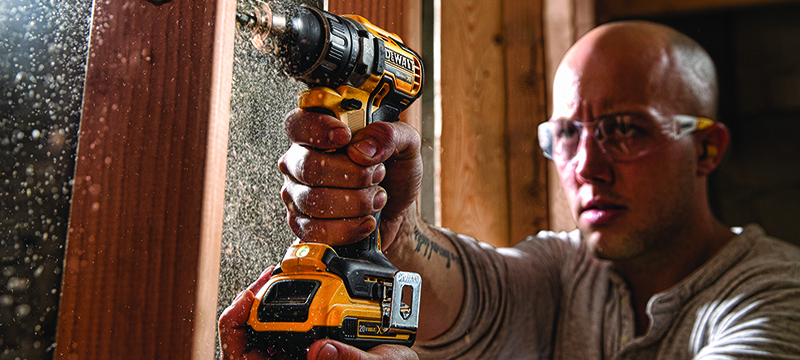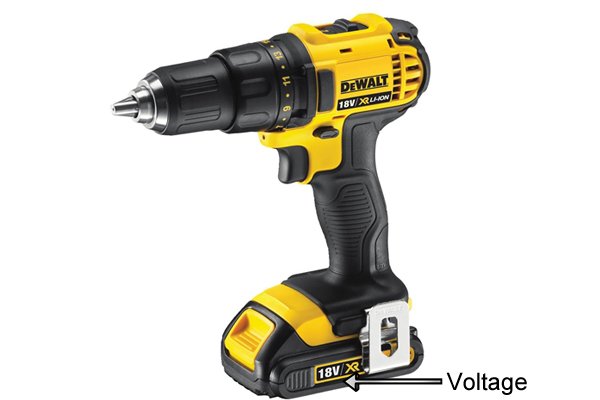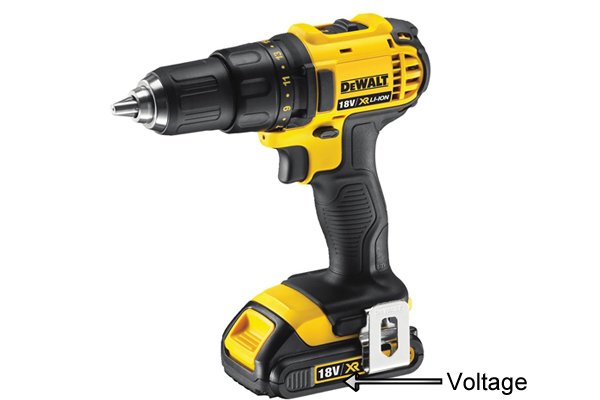Are you curious about what voltage power drills run on? Well, you’re in the right place! Power drills are incredibly handy tools that can help you tackle all sorts of projects around the house. But have you ever stopped to wonder how they actually work? One of the key elements of a power drill is its voltage, which determines its power and performance. So, let’s dive in and explore what voltage these mighty machines operate on!
When it comes to power drills, there’s a range of voltages you can find on the market. Typically, you’ll come across power drills with voltages of 12V, 18V, and even higher. Each voltage offers different levels of power, speed, and capabilities. But fear not, we’ll break down everything you need to know so you can choose the right power drill for your needs.
So, whether you’re a woodworking enthusiast, a DIY hobbyist, or just someone looking to tackle those household repairs, understanding the voltage of power drills is crucial. By the end of this article, you’ll have the knowledge to make an informed decision and unleash the power of your very own power drill! Let’s get started and explore the wonderful world of power drill voltages together.
What Voltage Do Power Drills Run On? – A Comprehensive Guide
Power drills are an essential tool for any DIY enthusiast or professional contractor. They allow for precision drilling and driving in a wide range of materials. One crucial aspect to consider when purchasing a power drill is the voltage it operates on. The voltage determines the power and performance of the drill, as well as its compatibility with different types of batteries. In this article, we will dive into the world of power drill voltages and provide you with all the information you need to know before making a purchase.
Understanding Voltage: The Basics
Before we delve into the specific voltages used in power drills, let’s first understand what voltage is and how it affects the performance of electrical devices. Voltage is the force that pushes an electrical current through a circuit. It is typically measured in volts (V). The higher the voltage, the more forceful the current and the greater the power output of the device.
The Common Voltages for Power Drills
When it comes to power drills, there are a few common voltage options available in the market. The most widely used voltages for power drills include 12V, 18V, and 20V (which is actually closer to 18V in terms of power output). Let’s take a closer look at each of these voltage options:
1. 12V Power Drills
12V power drills are typically considered entry-level or light-duty tools. They are ideal for small household tasks, such as assembling furniture, hanging shelves, and drilling into wood or drywall. 12V power drills are compact, lightweight, and easy to handle. They are powered by small lithium-ion batteries that provide enough power for most common tasks around the house. However, they may struggle with heavy-duty applications or drilling into tougher materials like metal or concrete.
2. 18V Power Drills
18V power drills are the most versatile option available for most DIYers and contractors. They offer a good balance between power and portability, making them suitable for a wide range of applications. 18V power drills can handle tasks such as drilling into wood, metal, and masonry, as well as driving screws and bolts. They are equipped with larger and more powerful lithium-ion batteries that can provide extended runtime and increased torque compared to 12V drills.
3. 20V Power Drills
Although marketed as 20V, these power drills actually operate at a voltage closer to 18V. The “20V” label is a result of engineering advancements that have allowed manufacturers to extract more power from the batteries. 20V power drills offer similar performance to 18V drills but with a slight increase in power output. They are popular among professionals who require maximum power for heavy-duty applications or prolonged use.
Key Considerations When Choosing a Power Drill Voltage
Now that we have discussed the common voltages for power drills, let’s explore some key considerations that can help you determine which voltage is right for your needs:
1. Type of Tasks
Consider the type of tasks you anticipate using the power drill for. If you primarily need it for light-duty tasks around the house, a 12V drill should suffice. For more demanding tasks or professional use, 18V or 20V drills offer greater power and versatility.
2. Battery Compatibility
Check the compatibility of the batteries across different voltage options. Some manufacturers have battery platforms that are interchangeable, allowing you to use the same batteries for multiple tools. This can be convenient and cost-effective if you already own other cordless tools from the same brand.
3. Weight and Portability
Consider the weight and portability of the drill. Generally, lower voltage drills are lighter and more compact, making them easier to handle for extended periods. If you plan on working in tight spaces or need to carry the drill around frequently, a lower voltage option may be more suitable.
4. Budget
Price is always a factor to consider when purchasing a power tool. Higher voltage drills tend to be more expensive due to their increased power and capabilities. Set a budget and choose the voltage option that aligns with your needs and financial resources.
In conclusion, the voltage of a power drill plays a crucial role in determining its power, performance, and suitability for different tasks. By understanding the common voltage options, considering your specific requirements, and assessing key factors like battery compatibility and portability, you can make an informed decision and select a power drill that meets your needs. Happy drilling!
Key Takeaways: What Voltage Do Power Drills Run On?
- Power drills typically run on two main voltages: 12 volts and 18 volts.
- Smaller drills, suitable for light DIY projects, usually operate on 12 volts.
- Heavier-duty drills used for professional or heavy-duty tasks commonly run on 18 volts.
- Higher voltage drills offer more power and torque for tougher jobs.
- It’s important to choose a power drill with the appropriate voltage for your specific needs and projects.
Frequently Asked Questions
Curious about power drill voltage? Here are some common questions and insightful answers!
1. How much voltage do power drills typically use?
Power drills usually run on either 12-volt or 18-volt batteries. These voltage ratings refer to the power supplied to the drill’s motor, determining its overall performance and capabilities. While both options can handle common drilling tasks, an 18-volt drill often offers more power and torque, making it suitable for heavier-duty applications.
It’s worth noting that higher voltage drills generally come with larger, bulkier batteries, which can affect their weight and portability. So, when deciding on a power drill, consider the tasks you’ll frequently tackle to determine the appropriate voltage for your needs.
2. Are there power drills available with different voltage options?
Yes, power drills are available with varying voltage options to cater to different needs. In addition to 12-volt and 18-volt drills, you can also find drills running on 20 volts, 24 volts, and even higher voltage systems. These higher voltage drills are often designed for more demanding applications, offering greater power and efficiency.
When choosing a drill, it’s crucial to consider the tasks you’ll be performing. If you primarily handle lightweight or occasional drilling tasks, a lower voltage option may suffice. However, for heavy-duty or professional applications, a higher voltage drill might be a better fit.
3. Can I use any voltage drill bit with a power drill?
Power drill bits are not limited to a specific voltage; instead, they are designed to be compatible with various drill types and models. When purchasing drill bits, regardless of their voltage rating, it’s important to ensure they are suitable for the material you’ll be working with. Different drill bits are designed for wood, metal, or masonry, so choose the appropriate bit to achieve the best results.
Remember that the voltage of the drill doesn’t affect the compatibility of the drill bits. Instead, it determines the power and performance of the drill itself. So, you can safely use drill bits compatible with your drill’s chuck size and material needs, regardless of the drill’s voltage rating.
4. Can I interchange batteries between different voltage power drills?
No, you generally cannot interchange batteries between power drills with different voltage ratings. Voltage differences correspond to different battery sizes, connectors, and power requirements. As a result, batteries designed for a specific voltage drill may not fit or work properly with a drill of a different voltage.
It’s essential to use the appropriate battery for your power drill, as using an incompatible battery can lead to performance issues, decreased battery life, or even damage to the drill. Always refer to the manufacturer’s guidelines to ensure you’re using the correct battery for your specific power drill model.
5. Can I use a power drill from one country in another country with a different voltage?
Using a power drill from one country in another country with a different voltage can be challenging. The voltage systems across countries can vary, and using a drill with an incompatible voltage can be dangerous and damage both the drill and the electrical systems.
However, some power drills have dual-voltage capabilities, allowing them to work in different voltages by adjusting a switch or using a voltage adapter. If you plan on using a power drill in a different country, it’s important to check the drill’s specifications or consult the manufacturer to determine its compatibility and any necessary precautions to take.

Summary
Power drills typically run on one of two voltages: 12 volts or 18 volts. The voltage determines the power and performance of the drill. 12-volt drills are smaller and lighter, perfect for light-duty tasks around the house. On the other hand, 18-volt drills are more powerful and suitable for heavy-duty projects. It’s important to choose the right voltage based on the type of work you’ll be doing.
When it comes to power drills, voltage matters. The higher the voltage, the more power the drill has. So, whether you’re putting up shelves or building furniture, make sure you choose a drill with the right voltage for the job. Happy drilling!

